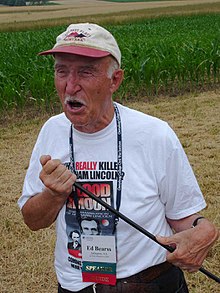The stolen and perverted writings of Homer and Ovid, of Plato and Cicero, which all men ought to contemn, are set up by artifice against the Sublime of the Bible; but when the New Age is at leisure to pronounce, all will be set right, and those grand works of the more ancient, and consciously and professedly Inspired men will hold their proper rank, and the Daughters of Memory shall become the Daughters of Inspiration, Shakspeare and Milton were curb'd by the general malady and infection from the silly Greek and Latin slaves of the sword. Rouse up, O Young Men of the New Age! Set your foreheads against the ignorant hirelings! For we have hirelings in the camp, the Court, and the University, who would, if they could, for ever depress mental, and prolong corporeal war. Painters! on you I call. Sculptors! Architects! suffer not the fashionable fools to depress your powers by the prices they pretend to give for contemptible works, or the expensive advertising boasts that they make of such works; believe Christ and His Apostles that there is a class of men whose whole delight is in destroying. We do not want either Greek or Roman models if we are but just and true to our own Imaginations, those Worlds of Eternity in which we shall live for ever, in Jesus our Lord.
And did those feet in ancient time
Walk upon England's mountains green?
And was the holy lamb of God
On England's pleasant pastures seen?
And did the Countenance Divine
Shine forth upon our clouded hills?
And was Jerusalem builded here
Among these dark Satanic mills.
Bring me my bow of burning gold!
Bring me my arrows of desire!
Bring me my spear! O clouds, unfold!
Bring me my chariot of fire!
I will not cease from mental fight,
Nor shall my sword sleep in my hand,
Till we have built Jerusalem
In England's green and pleasant land.
Would to God that all the Lord's people were Prophets. Numbers xi, ch. 26
Readers may be more familiar with Blake's poem through this medium:
As this tribute comes to a close, I'd like to reference one of Blake's poems that virtually all children read before the end of their middle schools years a half century ago. It's remarkably simple in form yet its questions brim with imagination and wonder. I so hope that "The Tyger" is still read and heard by young students so they can remember its message over their varied lifetimes.
Tyger, Tyger, burning bright,
In the forests of the night:
What immortal hand or eye,
Could frame thy fearful symmetry?
In what distant deeps or skies,
Burnt the fire in thine eyes?
On what wings dare he aspire?
What the hand, dare seize the fire?
And what shoulder & what art,
Could twist the sinews of thy heart?
And when thy heart began to beat,
What dread hand? & what dread feet?
What the hammer? What the chain,
In what furnace was thy brain?
What the anvil? what dread grasp.
Dare its deadly terrors clasp?
When the stars threw down their spears
And water'd heaven with their tears:
Did he smile his work to see?
Did he who made the Lamb make thee?
Tyger, Tyger burning bright,
In the forests of the night:
What immortal hand or eye,
Could frame thy fearful symmetry?
 |
| William Blake John Linnell, English, 1863 |
He who binds himself to a joy
Doth the winged life destroy
But he who kisses the joy as it flies
Lives in Eternity's sunrise
Eternity, William Blake, 1803
Sources
Photos and Illustrations:
wikipedia.com
Blake portrait, National Portrait Gallery, Washington, D.C.
Newton, Tate Gallery, London, U.K.blakearchive.org/Blake
Text:
wikipedia.com, Blake entry
blakearchive.org/Blake
bartleby.com/235/284.html
Jacob Bronowski, A Man Without A Mask, Seeker and Warburg, London, 1944





































